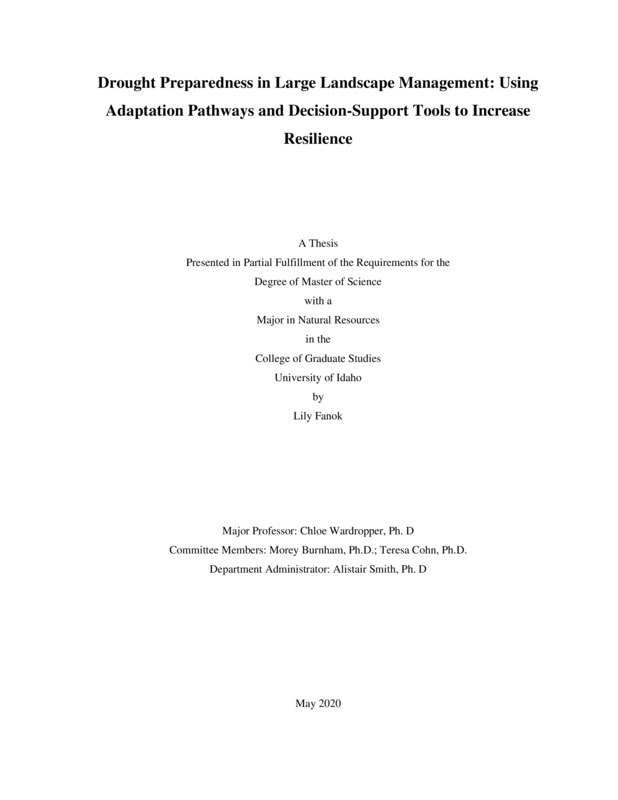Drought Preparedness in Large Landscape Management: Using Adaptation Pathways and Decision-Support Tools to Increase Resilience
Fanok, Lily. (2020-05). Drought Preparedness in Large Landscape Management: Using Adaptation Pathways and Decision-Support Tools to Increase Resilience. Theses and Dissertations Collection, University of Idaho Library Digital Collections. https://www.lib.uidaho.edu/digital/etd/items/fanok_idaho_0089n_11835.html
- Title:
- Drought Preparedness in Large Landscape Management: Using Adaptation Pathways and Decision-Support Tools to Increase Resilience
- Author:
- Fanok, Lily
- Date:
- 2020-05
- Keywords:
- Adaptation Pathways Decision-Support Tools Drought Rangelands Resilience Social-Ecological Systems
- Program:
- Natural Resources
- Subject Category:
- Water resources management; Climate change
- Abstract:
-
Climate projections suggest the United States (US) Northern Rockies region of Idaho and Montana may experience future drought severity and frequency trends, with implications for the sustainable management of rangeland systems. Efforts to increase drought resilience across this large landscape must include multiple stakeholder groups because of the region’s diverse mosaic of land ownership and priorities for land management, including sustaining ranching livelihoods and protecting wildlife connectivity. In partnership with a regional landscape collaborative, we conducted research in the High Divide region of the Northern Rockies of Idaho and Montana, a semi-arid sagebrush steppe rangeland system with similar ecological functions and socioeconomic context as many other US rangelands. This research looks to further understand drought preparedness and resilience in the High Divide region. Our study objectives were first to conduct focus groups to 1) understand past experiences of drought across diverse stakeholder groups, 2) determine characteristics of drought resilient landscape management, and 3) conceptualize adaptation pathways for increased resilience. Adaptation pathways are realistic trajectories created to inform potential futures of a system. Our findings suggest that shared conceptions of how to manage a resilient landscape, such as an emphasis on building social capital, while also acknowledging vulnerabilities, offer opportunity for collaboration towards drought adaptation. Secondly, we conducted interviews with landscape management organization employees in the High Divide region in order to, 1) identify which drought decision-support tools are being used, 2) describe tool-supported management actions across different types of organizations, and 3) understand barriers to decision-support tool adoption. Findings suggest a wide variety of tools are being used in this region by landscape management organizations to meet management objectives. However, use of decision-support tools for drought planning is limited and several barriers currently exist to increased adoption and use of tools, including lack of capacity and lack of management direction. This combined research informs future drought resilience collaborative action and specifically aims to inform regional tool development and decrease research – knowledge gaps.
- Description:
- masters, M.S., Natural Resources -- University of Idaho - College of Graduate Studies, 2020-05
- Major Professor:
- Wardropper, Chloe B
- Committee:
- Burnham, Morey; Cohn, Teresa
- Defense Date:
- 2020-05
- Identifier:
- Fanok_idaho_0089N_11835
- Type:
- Text
- Format Original:
- Format:
- application/pdf
- Rights:
- In Copyright - Educational Use Permitted. For more information, please contact University of Idaho Library Special Collections and Archives Department at libspec@uidaho.edu.
- Standardized Rights:
- http://rightsstatements.org/vocab/InC-EDU/1.0/

